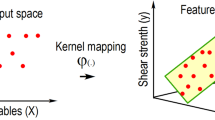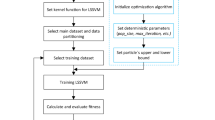Abstract
This research proposes an alternative for estimating shear strength of soil based on a hybridization of Support Vector Regression (SVR) and Particle Swarm Optimization (PSO). SVR is used as a function approximation method for making prediction of the soil shear strength based on a set of twelve variables including sample depth, sand content, loam content clay content, moisture content, wet density, dry density, void ratio, liquid limit, plastic limit, plastic index, and liquid index. The hybrid framework, named as PSO–SVR, relies on PSO, as a metaheuristic, to optimize the training phase of the employed function approximator. A data set consisting of 443 soil samples associated with the experimental results of shear strength has been collected from a housing project in Vietnam. This data set is then used to train and verify the performance of the PSO–SVR model specifically constructed for shear strength estimation. The hybrid model has achieved a good modeling outcome with Root Mean Square Error (RMSE) = 0.038, Mean Absolute Percentage Error (MAPE) = 9.701%, and Coefficient of Determination (R2) = 0.888. Hence, the PSO–SVR model can be a potential alternative to be participated in the design phase of high-rise housing projects.









Similar content being viewed by others
References
Vanapalli SK, Fredlund DG (2000) Comparison of different procedures to predict unsaturated soil shear strength. Adv Unsatur Geotech. https://doi.org/10.1061/40510(287)13
Tien Bui D, Hoang N-D, Nhu V-H (2018) A swarm intelligence-based machine learning approach for predicting soil shear strength for road construction: a case study at Trung Luong National Expressway Project (Vietnam). Eng Comput. https://doi.org/10.1007/s00366-018-0643-1
Das BM, Sobhan K (2013) Principles of geotechnical engineering. Cengage Learning, Boston (ISBN-10:1133108660)
Nam S, Gutierrez M, Diplas P, Petrie J (2011) Determination of the shear strength of unsaturated soils using the multistage direct shear test. Eng Geol 122(3):272–280. https://doi.org/10.1016/j.enggeo.2011.06.003
Rassam DW, Williams DJ (1999) A relationship describing the shear strength of unsaturated soils. Can Geotech J 36(2):363–368. https://doi.org/10.1139/t98-102
Gan JKM, Fredlund DG, Rahardjo H (1988) Determination of the shear strength parameters of an unsaturated soil using the direct shear test. Can Geotech J 25(3):500–510. https://doi.org/10.1139/t88-055
Hoang N-D, Tien Bui D, Liao K-W (2016) Groutability estimation of grouting processes with cement grouts using differential flower pollination optimized support vector machine. Appl Soft Comput 45:173–186. https://doi.org/10.1016/j.asoc.2016.04.031
Prayogo D, Susanto YTT (2018) Optimizing the prediction accuracy of friction capacity of driven piles in cohesive soil using a novel self-tuning least squares support vector machine. Adv Civ Eng 2018:9. https://doi.org/10.1155/2018/6490169
Chou J-S, Yang K-H, Lin J-Y (2016) Peak shear strength of discrete fiber-reinforced soils computed by machine learning and metaensemble methods. J Comput Civ Eng 30(6):04016036. https://doi.org/10.1061/(ASCE)CP.1943-5487.0000595
Chou J-S, Chong WK, Bui D-K (2016) Nature-inspired metaheuristic regression system: programming and implementation for civil engineering applications. J Comput Civ Eng 30(5):04016007. https://doi.org/10.1061/(ASCE)CP.1943-5487.0000561 doi
Sharma LK, Singh R, Umrao RK, Sharma KM, Singh TN (2017) Evaluating the modulus of elasticity of soil using soft computing system. Eng Comput 33(3):497–507. https://doi.org/10.1007/s00366-016-0486-6
Mozumder RA, Laskar AI, Hussain M (2018) Penetrability prediction of microfine cement grout in granular soil using artificial intelligence techniques. Tunn Undergr Space Technol 72:131–144. https://doi.org/10.1016/j.tust.2017.11.023
Suman S, Mahamaya M, Das SK (2016) Prediction of maximum dry density and unconfined compressive strength of cement stabilised soil using artificial intelligence techniques. Int J Geosynth Ground Eng 2(2):11. https://doi.org/10.1007/s40891-016-0051-9
Hossein Alavi A, Hossein Gandomi A (2011) A robust data mining approach for formulation of geotechnical engineering systems. Eng Comput 28(3):242–274. https://doi.org/10.1108/02644401111118132 doi
Hoang N-D, Bui DT (2018) Predicting earthquake-induced soil liquefaction based on a hybridization of kernel Fisher discriminant analysis and a least squares support vector machine: a multi-dataset study. Bull Eng Geol Environ 77(1):191–204. https://doi.org/10.1007/s10064-016-0924-0
Shahin MA (2015) A review of artificial intelligence applications in shallow foundations. Int J Geotech Eng 9(1):49–60. https://doi.org/10.1179/1939787914Y.0000000058
Lary DJ, Alavi AH, Gandomi AH, Walker AL (2016) Machine learning in geosciences and remote sensing. Geosci Front 7(1):3–10. https://doi.org/10.1016/j.gsf.2015.07.003
Shahin MA (2016) State-of-the-art review of some artificial intelligence applications in pile foundations. Geosci Front 7(1):33–44. https://doi.org/10.1016/j.gsf.2014.10.002
Fredlund DG, Morgenstern NR, Widger RA (1978) The shear strength of unsaturated soils. Can Geotech J 15(3):313–321. https://doi.org/10.1139/t78-029
Gan K, Fredlund D (1988) Multistage direct shear testing of unsaturated soils. Geotechnical Test J 11(2):132–138. https://doi.org/10.1520/GTJ10959J
Vanapalli SK, Fredlund DG, Pufahl DE, Clifton AW (1996) Model for the prediction of shear strength with respect to soil suction. Can Geotech J 33(3):379–392. https://doi.org/10.1139/t96-060
Fredlund DG, Xing A, Fredlund MD, Barbour SL (1996) The relationship of the unsaturated soil shear to the soil–water characteristic curve. Can Geotech J 33(3):440–448. https://doi.org/10.1139/t96-065
Abramento M, Carvalho CS (1989) Geotechnical parameters for the study of natural slopes instabilization at ‘Serra do Mar’ Brazil. In: Proceedings 12th international conference soil mechanics foundations engineering Rio de Janeiro, vol 3, pp 1599–1602
Katte V, Blight G (2012) The roles of solute suction and surface tension in the strength of unsaturated soil. In: Mancuso C, Jommi C, D’Onza F (eds) Unsaturated soils: research and applications. Springer, Berlin, pp 431–437
Leong EC, Nyunt TT, Rahardjo H (2013) Triaxial testing of unsaturated soils. In: Laloui L, Ferrari A (eds) Multiphysical testing of soils and shales. Springer series in geomechanics and geoengineering. Springer, Berlin, Heidelberg, pp 33–44
Bishop CM (2011) Pattern recognition and machine learning (information science and statistics). Springer, Berlin (ISBN-10: 0387310738)
Pham BT, Son LH, Hoang T-A, Nguyen D-M, Tien Bui D (2018) Prediction of shear strength of soft soil using machine learning methods. CATENA 166:181–191. https://doi.org/10.1016/j.catena.2018.04.004
Kiran S, Lal B, Tripathy SS (2016) Shear strength prediction of soil based on probabilistic neural network. Indian J Sci Technol 9(41):1–6. https://doi.org/10.17485/ijst/2016/v9i41/99188
Hashemi Jokar M, Mirasi S (2017) Using adaptive neuro-fuzzy inference system for modeling unsaturated soils shear strength. Soft Comput. https://doi.org/10.1007/s00500-017-2778-1
Jang JSR (1993) ANFIS: adaptive-network-based fuzzy inference system. IEEE Trans Syst Man Cybern 23(3):665–685. https://doi.org/10.1109/21.256541
Hoang N-D, Liao K-W, Tran X-L (2018) Estimation of scour depth at bridges with complex pier foundations using support vector regression integrated with feature selection. J Civ Struct Health Monit. https://doi.org/10.1007/s13349-018-0287-2
Wang H, Xu D (2017) Parameter selection method for support vector regression based on adaptive fusion of the mixed kernel function. J Control Sci Eng 2017:12. https://doi.org/10.1155/2017/3614790
Çevik A, Kurtoğlu AE, Bilgehan M, Gülşan ME, Albegmprli HM (2015) Support vector machines in structural engineering: a review. J Civ Eng Manag 21(3):261–281. https://doi.org/10.3846/13923730.2015.1005021
Tien Bui D, Bui Q-T, Nguyen Q-P, Pradhan B, Nampak H, Trinh PT (2017) A hybrid artificial intelligence approach using GIS-based neural-fuzzy inference system and particle swarm optimization for forest fire susceptibility modeling at a tropical area. Agric For Meteorol 233:32–44. https://doi.org/10.1016/j.agrformet.2016.11.002
Sachdeva S, Bhatia T, Verma AK (2017) Flood susceptibility mapping using GIS-based support vector machine and particle swarm optimization: a case study in Uttarakhand (India). In: 2017 8th International conference on computing, communication and networking technologies (ICCCNT), 3–5 July 2017, pp 1–7. https://doi.org/10.1109/ICCCNT.2017.8204182
Hacibeyoglu M, Ibrahim MH (2018) A novel multimean particle swarm optimization algorithm for nonlinear continuous optimization: application to feed-forward neural network training. Sci Program 2018:9. https://doi.org/10.1155/2018/1435810
El-Ghandour HA, Elbeltagi E (2018) Comparison of five evolutionary algorithms for optimization of water distribution networks. J Comput Civ Eng 32(1):04017066. https://doi.org/10.1061/(ASCE)CP.1943-5487.0000717 doi
Jain NK, Nangia U, Jain J (2018) A review of particle swarm optimization. J Inst Eng (India) Ser B 99(4):407–411. https://doi.org/10.1007/s40031-018-0323-y
Vapnik VN (1998) Statistical learning theory. Wiley, Hoboken (printed in the United States of America)
Kang F, Li J (2016) Artificial bee colony algorithm optimized support vector regression for system reliability analysis of slopes. J Comput Civ Eng 30(3):04015040. https://doi.org/10.1061/(ASCE)CP.1943-5487.0000514
Smola AJ, Schölkopf B (2004) A tutorial on support vector regression. Stat Comput 14(3):199–222. https://doi.org/10.1023/b:stco.0000035301.49549.88
Wu Y-H, Shen H (2018) Grey-related least squares support vector machine optimization model and its application in predicting natural gas consumption demand. J Comput Appl Math 338:212–220. https://doi.org/10.1016/j.cam.2018.01.033
Eberhart RC, Kennedy J (1995) A new optimizer using particle swarm theory. In: Proceedings of the sixth international symposium on micro machine and human science, New York, NY, pp 39–43
Clayton CR (1995) The standard penetration test (SPT): methods and use. Construction Industry Research and Information Association, London
Schmertmann JH (1978) Guidelines for cone penetration test: performance and design. Federal Highway Administration, Washington, DC
(ASTM) ASfTaM (2005) ASTM D4648/D4648M-16, standard test methods for laboratory miniature vane shear test for saturated fine-grained clayey soil. Active Standard ASTM D4648, vol ASTM International, West Conshohocken, PA, 2016. http://www.astm.org
Hagan MT, Menhaj MB (1994) Training feedforward networks with the Marquardt algorithm. IEEE Trans Neural Netw 5(6):989–993. https://doi.org/10.1109/72.329697
Breiman L, Friedman JH, Olshen RA, Stone CJ (1984) Classification and regression trees. Wadsworth and Brooks, Montery (ISBN-13: 978-0412048418$4)
Jang J-SR, Sun C-T, Mizutani E (1997) Neuro-fuzzy and soft computing: a computational approach to learning and machine intelligence. Pearson, London
Friedman JH, Roosen CB (1995) An introduction to multivariate adaptive regression splines. Stat Methods Med Res 4(3):197–217. https://doi.org/10.1177/096228029500400303
Matwork (2017) Statistics and machine learning toolbox User’s Guide. Matwork Inc. https://www.mathworks.com/help/pdf_doc/stats/stats.pdf. Accessed 28 Apr 2018
Jekabsons G (2016) ARESLab: adaptive regression splines toolbox for Matlab/Octave. Technical report, Riga Technical University. http://www.csrtulv/jekabsons/. Accessed 15 July 2018
Mendenhall W, Sincich TT (2011) A second course in statistics: regression analysis, 7th edn. Pearson, London
Acknowledgements
This research was funded by the Geographic Information Science Research group, Ton Duc Thang University, Ho Chi Minh city, Vietnam. We would like to thank the Topgeo construction and Investigation Joint Stock Company (Hanoi) and Vingroup Joint Stock Company (Vietnam) for providing the data for this research.
Author information
Authors and Affiliations
Corresponding author
Ethics declarations
Conflict of interest
We declare that we do not have any commercial or associative interest that represents a conflict of interest in connection with the work submitted.
Additional information
Publisher’s Note
Springer Nature remains neutral with regard to jurisdictional claims in published maps and institutional affiliations.
Rights and permissions
About this article
Cite this article
Nhu, VH., Hoang, ND., Duong, VB. et al. A hybrid computational intelligence approach for predicting soil shear strength for urban housing construction: a case study at Vinhomes Imperia project, Hai Phong city (Vietnam). Engineering with Computers 36, 603–616 (2020). https://doi.org/10.1007/s00366-019-00718-z
Received:
Accepted:
Published:
Issue Date:
DOI: https://doi.org/10.1007/s00366-019-00718-z




